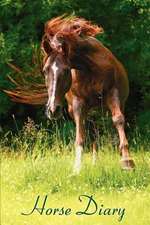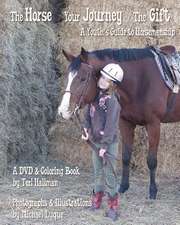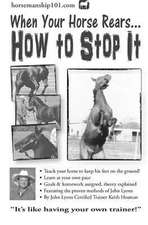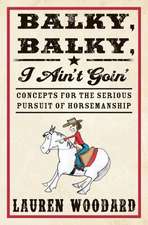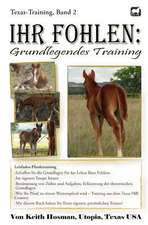What Your Horse Wants You to Know: What Horses' "Bad" Behavior Means, and How to Correct It
Autor Gincy Self Bucklinen Limba Engleză Paperback – 2 oct 2003
| Toate formatele și edițiile | Preț | Express |
|---|---|---|
| Paperback (1) | 110.68 lei 22-36 zile | |
| Howell (TP) – 2 oct 2003 | 110.68 lei 22-36 zile | |
| Hardback (1) | 154.04 lei 22-36 zile | |
| Howell Books – 30 sep 2003 | 154.04 lei 22-36 zile |
Preț: 110.68 lei
Nou
21.18€ • 22.17$ • 17.52£
Carte disponibilă
Livrare economică 17-31 martie
Specificații
ISBN-10: 0764540858
Pagini: 194
Dimensiuni: 160 x 233 x 13 mm
Greutate: 0.35 kg
Editura: Howell (TP)
Locul publicării:Hoboken, United States
Descriere
Textul de pe ultima copertă
"This is a book for everyone who has ever looked at the constantly increasing list of methods and systems marketed as 'horsemanship' and wondered which of the many possible approaches would be most suitable for a particular behavior problem. Gincy Bucklin has distilled her many years of experience with horses and riders into a very useful, step-by-step, hands-on book. Bucklin's writing is smooth and easy to read, and no matter where you open this book, you'll find that her deep respect and affection for both equines and humans shines through."
-Dr. Jessica Jahiel, author of Riding for the Rest of Us
"Gincy Bucklin uses her decades-long experience with horses to answer that most frequently asked question: 'Why did my horse do that?' And she comes up with creative solutions that weave together traditional horse handling with the best of modern horse training, including my own personal favorite, clicker training."
-Alexandra Kurland, author of Clicker Training for Your Horse and The Click That Teaches video lesson series
It takes time for a horse to learn everything we want him to know. If we don't make our intentions clear to him in ways that he can understand, or if we don't listen to what he wants, problems may result. Featuring easy-to-follow, step-by-step advice, What Your Horse Wants You to Know reveals how to communicate effectively with your horse to create an atmosphere of mutual cooperation.
What Your Horse Wants You to Know focuses on improving your horse's behavior on the ground, so you can develop relationship and communications skills without the more challenging problems that arise once you're on his back.
- Use your entire body to communicate with your horse
- Show your horse that you respect his needs and feelings
- Be patient and consistent with your horse while having fun
- Understand your horse's fears and overcome them
- Respond appropriately to physiological or nutritional problems
- Use praise to make your horse feel confident and successful










